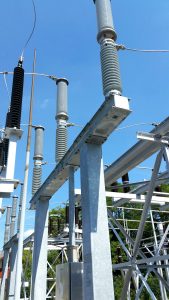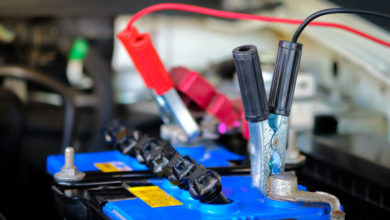Recent improvements keep Spencerport Municipal Electric running safely and reliably

Keeping the power on is a constant job for those who work to provide homes with electricity and recently in Spencerport, the village’s Municipal Electric Department installed a new Flooded Battery System complete with spill containment.
“The new system replaces an outdated 15 year old battery system,” says Spencerport Municipal Electric Superintendent Owen McIntee. “With that came a new dialer system, so SME employees are notified via text messages if a battery or building temperature alarm comes into the station.”
Additionally, SME employees earlier this year installed an 18 inch deep rubber material system for oil containment around the entire perimeter of the substation.

“In the case of a catastrophic event that causes oil to leak from one of the two transformers, this new containment system would contain the oil within the substation fenced area and prevent any oil from spilling into nearby Northrup Creek,” McIntee explains. He notes that the substation continually undergoes routine maintenance and capital improvements.
In 2013 and 2014, SME employees replaced both 115kv circuit switchers, McIntee says. “These sophisticated and expensive devices control transmission voltages that supply power to each substation transformer.”
Also, every five years, SME employees and engineers conduct extensive substation breaker maintenance and testing. “All these activities which take place are necessary to keep the substation operating in a safe and reliable state, so that proper, constant, reliable power is distributed to our customers,” McIntee says.
“The small profit we realize from our annual revenues is continually reinvested back into our substation and overhead/underground pole facilities,” he continues. “The equipment that we purchase today is more state of the art and highly efficient compared to equipment that was manufactured 30 years ago. Because of this strategy, our systems are constantly upgraded, which helps deliver safe reliable power to our customers.”

Weekly, inspections of all critical substation components are performed and McIntee notes that every day, a great deal of work goes on behind the scenes at the substation and out on the overhead and underground lines. “The fascinating part of electric utility work,” he observes, “is that as we go about our routine day, customer power is not interrupted.”
A bit about Spencerport’s electric history
by Evelyn Dow
The signs at the gateways to the village proclaim it: “Welcome to Spencerport – A Public Power Community.” How and when did the village get “plugged in” as a system?
Various mentions in historical writings indicate Spencerport village had electrical service by 1917, perhaps earlier in some areas. A photo dated 1910 found in the “Pathways to the Past” collection of Ogden historical photographs shows poles and electrical wires at the rear of buildings on the east side of Union Street in the downtown business area. In early days, the power was purchased from Niagara Hudson Power Co. which later became Niagara Mohawk.
To the south, Churchville established a municipal system by 1921. On the eastern edge of Monroe County, Fairport had electricity in the business district in 1911. Those three villages continue to have electrical systems today, offering residents within their districts cheaper electric rates than those of publicly owned systems.
Following Thomas Edison’s fashioning of an electrical ‘system’ in a New York City neighborhood in 1882, companies formed throughout the state to provide electricity at a profit to larger residential areas. Away from the concentrated areas of demand in towns and cities, small communities created their own power often times, servicing defined areas as non profit entities and creating self supporting systems.
By 1930, several New York state municipalities had formed the Municipal Electric Utilities Association (MEUA), an organization which “aims to foster the efficient operation of publicly owned and operated electric systems including the production, distribution, conservation and prudent use of electric power and energy for public service.” (MEUA website). Today, there are 51 members of the association.
As a group, the municipalities have been able to lobby to sustain their mission. “In 1956, the group supported the Lehman-Roosevelt bill that created the Niagara Redevelopment Act which included a ‘fair share’ provision of the hydroelectric power to municipal and cooperatives called the preference clause.” (MEUA website). The fight to keep the less expensive hydropower allocations results in cheaper electric rates for municipal systems. Several attempts to substantially reduce the amount power available to municipals have meant members had to address challenges in late 1970s and ‘80s when politicians in NYC and adjacent counties pushed to reduce the amount of hydroelectric allocated to municipal systems. MEUA members negotiated contracts in 1986, 1991 and 2003, and long term contracts to 2025, according to the state organization.
Adjustments to those contracts have restructured the electrical allocations somewhat. When the service area’s power consumption reaches an established level at the lower rate, the system buys into more expensive supplies, thus Spencerport Municipal Electric customers and others in the MEUA group see two rates on their monthly utility statement – one for basic power and a PPAC (Purchase Power Adjustment Clause) rate. As an example, when the local grid draws more power, such as during winter heating season in a district where many homeowners heat with electric systems, the hydro cap is reached more quickly and other more expensive sources are tapped.
In its beginnings, a public power system might have powered two dozen street lights and less than 50 homes daily for a specific duration each day with as little as 150 kilovolt amperes (kva). Such was the case in Fairport. The fledgling system was responsible for poles, lines, safe transmission and required to be driven by customer needs. Today’s public systems serve more customers with the same criteria to be both efficient and effective. As outlined in the accompanying article regarding Spencerport’s municipal electric system’s, there’s a lot involved – substation upgrades, bucket trucks, infrastructure repairs and replacement, specialized hardware and trained employees all have to function to keep the power ‘on.’
Somewhat like the Erie Canal provided commercial and travel opportunities to a growing Spencerport community, another means of conveyance, the Buffalo, Lockport and Rochester interurban railroad, an electric trolley system, started in 1906, used a growing power system to transport people and goods in western New York. It crossed Union Street at West Avenue and stopped at a station which has been relocated to the south bank of the Erie Canal, in the vicinity of its original site. The Depot served the interurban trolley line from 1908 to 1931, offering commuters access to travel, employment and shopping opportunities to the east and west which was noted to be cheaper and faster than railroads in the area thanks to the use of electricity.
Resources from which this information was paraphrased include: MEUA website, Village of Fairport website, Village of Churchville website, Perinton Historical Society website, Pathways to the Past historical archive, Rochester, Lockport and Buffalo Railroad website, 150 years in Ogden/100 years in Spencerport by Earl White.


